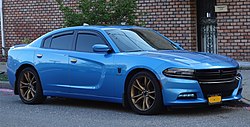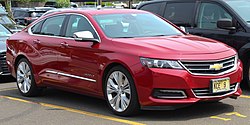Full-size vehicle
A full-size car is a marketing term used in North America for an automobile larger than a mid-size car. Traditional U.S. full-size passenger cars were designed to be comfortable for six occupants and their luggage for long-distance driving. The United States Environmental Protection Agency (EPA) currently uses the term "large car" to mean full-size cars based on their combined interior passenger and luggage volume. A full-size SUV (or CUV), is a utility vehicle that has over 100 cubic feet (2.8 m3) of cargo volume.[1] This is measured when the rear seats are folded or removed for more cargo capacity.[1] Both full-size and mid-size SUVs and CUVs have three rows of seating (8 or 9 passengers).[2] A full size van is a marketing term used for a van larger than a minivan. Seating is one difference. A full-size van may be equipped to seat up to 15 passengers.[3] A minivan often seats up to 8.[3]
Full-size Vehicle Media
Dodge Charger (2015–2023 model shown)
Chevrolet Impala (2014–2020 model shown)
Chrysler 300 (2015–2023 model shown)
References
| Wikimedia Commons has media related to Lua error in Module:Commons_link at line 62: attempt to index field 'wikibase' (a nil value).. |
- ↑ 1.0 1.1 "What You Should Know Before Buying a SUV". Edmunds.com, Inc. Retrieved 30 January 2015.
- ↑ "Which Is Right for You: Midsize SUV or Full-Size SUV?". AutoTrader.com, Inc. Retrieved 30 January 2015.
- ↑ 3.0 3.1 "What You Should Know Before Buying a Minivan/Van". Edmunds.com, Inc. Retrieved 30 January 2015.



